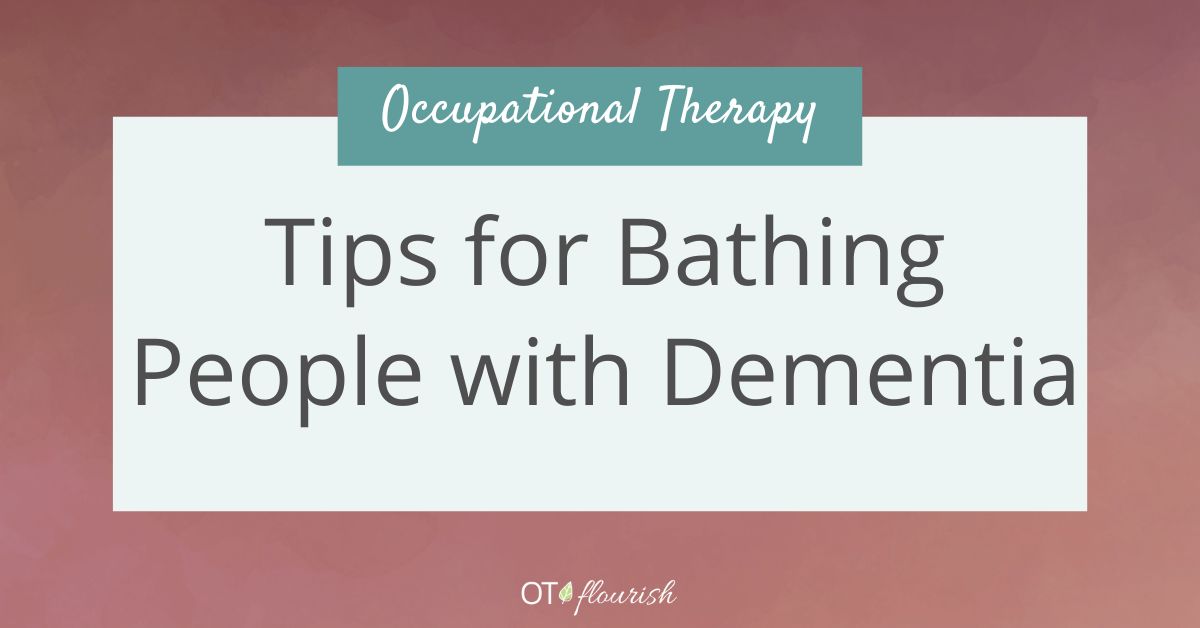The struggle is real. Dementia bathing or patients with other cognitive impairments is one of the biggest struggles from caregivers. There is fighting, arguing, and frustration. There is worry about body odor, risk of infection and being in pain due to chaffing and soreness.
Everyone that struggles with bathing goes through this. First thing to focus on is that you cannot change your loved one. Trying to rationalize, over explain or justify taking a bath typically does not help and keeping in mind all forms of pushback from the patient is a form of communication.
The focus needs to be on changing and adapting how we approach them, how we set up their environment and how we interact with them.
How to get someone with dementia to shower?
Encouraging someone with dementia to shower involves creating a structured and familiar routine while addressing their specific needs and preferences. Start by:
- Establishing a consistent shower schedule to reduce anxiety and resistance, ensuring the environment is safe and comfortable
- Use verbal cues and visual prompts such as a favorite towel or soothing music to trigger the activity
- Employ gentle and patient communication
- Break down the task into simple steps
- Provide hands-on assistance as needed, always respecting their dignity and autonomy.

Collaborating with the individual, their caregivers, and family members to incorporate meaningful incentives or rewards can also help motivate showering, making it a positive and routine experience that promotes hygiene and overall well-being.
Let’s break this down for a more practical perspective.
So let’s dig into how occupational therapy practitioners can work on dementia bathing without a battle and one of the first steps is to complete an ADL assessment to gather information from the carepartner such as a behavior log, get a baseline of information completing a cognitive assessment like the Allen Cognitive Level Screen (ACLS) and the patient’s areas of difficulties (if you are an OT Accelerator member, we have all the information in our Dementia 101 course to complete an assessment, goal writing, documentation and interventions here).
The Foundation
- Use eye contact, touch and calming words and familiar scents.
- Make sure equipment is set up in bathroom prior to bathing, which all help in reducing a fear of falling:
- nonslip bath treads,
- grab bars,
- shower bench or chair,
- hand held shower with an on/off button
- Establish a routine and anything that they did or used prior to having dementia should try to be used – a favorite soap, did they use a washcloth or a sponge to bathe? Shower or tub? What time of day did they typically bathe – before bed or right away in the morning?
- Allow extra time – slow the task down, do not rush through.
- Make sure all caregivers that are helping with bathing know the routine to ensure consistency.
The Environment
- Simply state instructions – do not over explain, use short sentences and give them longer to respond.
- Ask “yes” or “no” questions – example: Water too hot? vs How hot do you want the water?
- Chat and have conversation during bathing to keep them calm – familiar topics like flowers, cooking, weather vs complex topics like news, current events or activities going on in the family, etc.
- Reduce noise, loud conversations and music.
- Sit or squat next to them to help them bath so they can see you and see what you are doing. Do not stand above and look down on the caree in an authoritative position.
The Preparation
- Get them to agree to bathing. You may have to get creative, but a few examples include:
- Telling them someone special (ex: a family member, clergy member, etc) is coming over for a visit or you are going to be visiting them and it might be nice for them to freshen up.
- Get dirty! Have them do some baking, garden, organize some things out in the shed – anything to engage them, but make them obviously dirty. This can trigger a response that they want to bathe to clean up.
- Sometimes changing the term from “bathing” to “spa” or “freshening up” decreases anxiety and makes them more agreeable.
- Have them bring towels or toilet paper into the bathroom for you (half the battle is getting them in the bathroom in the first place) and have them smell a familiar soap or shampoo prior to bathing. This can illicit the memory of bathing and makes them more agreeable to the task.
- If agitated, use techniques to calm them down prior to bathing such as singing, distraction or even prescribed medications by your physician.
- Turn the up the heat in the bathroom so it is very warm. This way, there is no excuse that the room is too cold.
Time to Bathe
If possible, bathe your caree on their dominant side – so if they are right handed, you want to try and sit at their level on the right side. Have them remove clothing in the bathroom and if possible, while on the shower chair or bench that you are using in the bathing area.
Tell them with a simple direction to “take off your shirt” and even pretend you are taking off your shirt so the directions are clear. One article of clothing at a time and have them take off as much as their own clothing as they can – this helps them feel like they are in control.
After removal of the shirt, place a warm towel (right out of the drier) and drape over shoulders to help with modesty and warmth. Even if modesty wasn’t an issue in the past, it may be now and being covered makes people feel safe, secure and not vulnerable.
Then have them remove the pants and underwear with simple direction and pretending to remove your pants as a demonstration. Again, place a warm towel on their lap.
Lastly, remove socks.
Make sure the temperature of the water is warm and use a hand held shower with an on/off button.
This allows you to get the water ready to the best temperature, turn it in the “off” position, get your loved one in the shower and you are ready to go! They won’t have to sit in the showering area, freezing cold and wait for you to adjust the water to the correct temperature. Also, you are able to manually direct the water, which is more comforting for the person not in control of the shower.
If the caree is calm and wants to remove the warm towels, let them, but if they are resistant, start by getting the towel wet with the water using the hand held shower. In many cases when the towel (and/or bra and underwear if they are resistant to removing them) gets wet, they will naturally want to take them off.
Complete the bathing task with demonstration, basic instruction and showing them what you will be doing at each step.
When you are done bathing, make sure you have a few more warm towels ready to go. A tip to keep the towels warm is put them in a trash bag after you get them out of the drier, so they will stay warm until the end of the bathing task.
Dry them off, hand them the clothing, one at a time and demonstrate putting the clothes on – just reversing the steps you used to get them undressed. Be sure to keep them covered for modesty and warmth.
What is your best tip for bathing someone with Alzheimer’s or dementia?
Leave a comment to share!
For more information on bathing someone with Alzheimer’s or dementia, check out the Alzheimer’s Association for additional resources.








4 thoughts on “Dementia Bathing Tips”
Excellent- I have this issue at the moment with a client, it’s really helpful
awesome! Hope one of these tips works for them!
My mom is in assisted living. They are wonderful but the shifts change throughout the week and it’s hard to get consistency with the routine. What can help with this?
It really is tough. One thing to suggest is to write up a bulleted list of a basic plan and instruction for consistency and post it in your mom’s room. If you have intermittent care meetings with staff you could bring it up there (or director of nursing directly) and request that you “want this to be a part of her care plan”. Depending on the level of care they provide there, if it is a part of her care plan, it becomes a part of their record and it is much more likely to be carried out more consistently. Still a challenge though 🙁 Hope that helps!